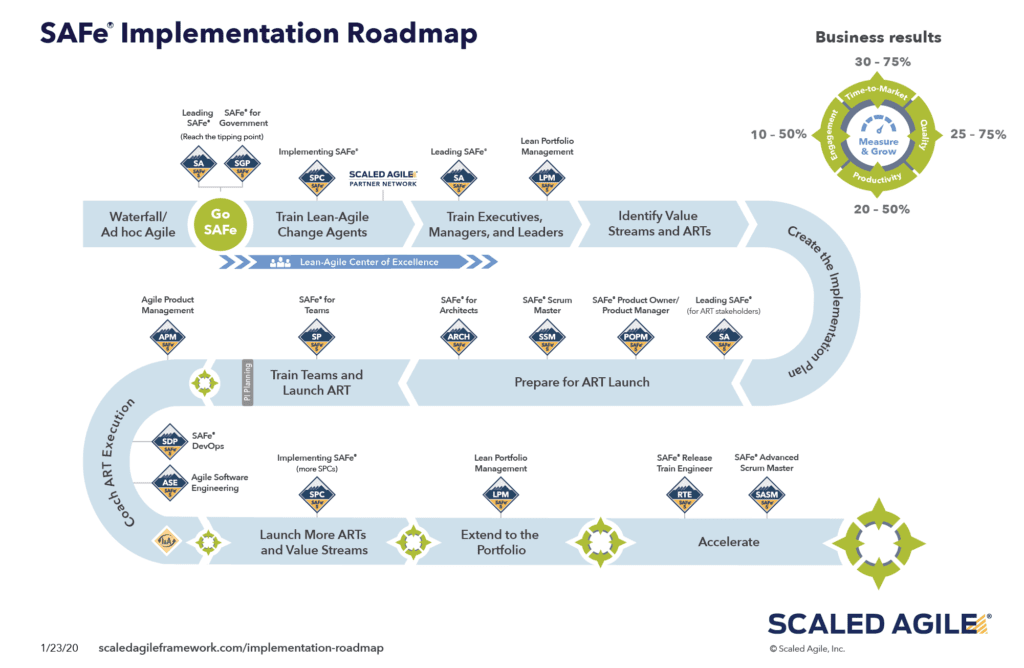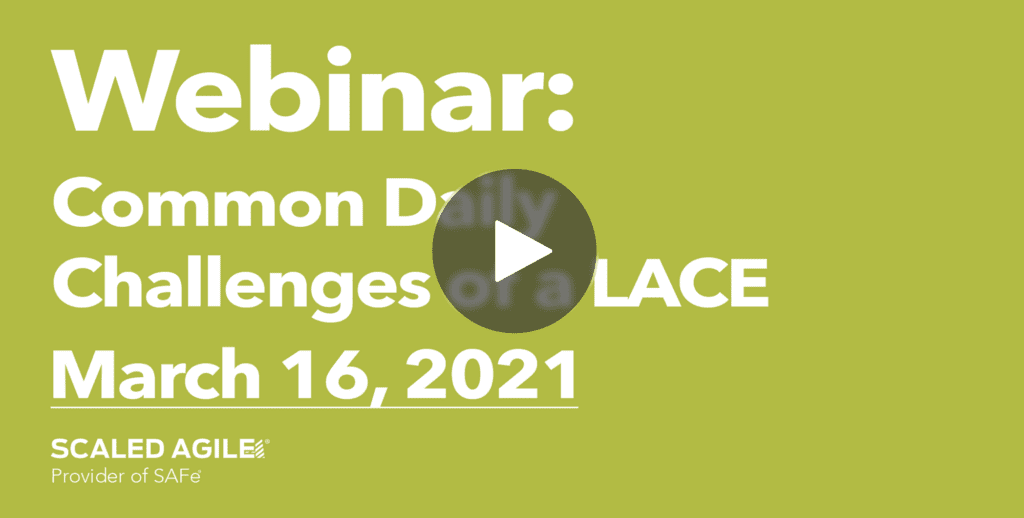Transformations don’t happen in a vacuum. They need momentum, stewardship, and what John P. Kotter calls “a guiding coalition that operates as an effective team.” In the Scaled Agile Framework® (SAFe®), this coalition is the lean-agile center of excellence (LACE). The LACE is a cornerstone of successful transformations because it
- Encourages continuity and manages expectations
- Sustains the change by sharing success patterns
- Reduces the “time to transformation” by focusing on execution and progress
LACEs aren’t a new concept, and you can find a helpful overview of how they work in the current Framework article. But this piece will expand on that article by introducing new findings from 2022 field research. We observed organizations with a well-established LACE practicing the following advancements:
- Leading the transition to Lean Portfolio Management (LPM)
- Facilitating effective events, like Value Stream Identification, to organize around value
- Nurturing the employee development and job architecture needed to thrive in a SAFe environment
A LACE will grow and evolve as much as the entire organization during the change process. We’ll explore each stage of this evolution through key highlights from our research, which include:
- A better understanding of how LACEs evolve
- Concrete guidance for success based on real-world experience
- A new evolution in the LACE model: LACE as a Network, once referred to as Mesh
You won’t see this new networked model or some of the additional insights in the Framework article; it’s an emerging pattern discovered as part of our research into SAFe implementations. Our research uncovered other key themes shared among LACEs as they start and develop. These additional themes are:
- Top LACE concerns, like staffing and showcasing progress
- Inter-lace collaboration
- Sustainable change
- “Continuous learning needs” beyond the class
We’ll show how these themes apply as you start and grow your LACE. Understanding your LACE journey will support transformation success from the beginning and help you avoid burnout, common mistakes, and blocks to improving business agility.
Building an Effective LACE
When should you start your first LACE? The SAFe Implementation Roadmap suggests that LACE creation should coincide with the beginning of a transformation. While things won’t be perfect in the first stages, starting a LACE early on will help you build momentum, steer critical decisions, and equip new teams.
Restating the same question differently: When should you form a LACE with members who are fully dedicated to leading the transformation? This question is particularly relevant to LACE groups that are part-time or voluntary. While external expert coaches might work at first, over time you need to build internal coaching capabilities and dedicate people to extend and sustain the SAFe transformation.
What are the first steps toward organizing an effective, impactful coalition? Below we outline six essential steps for successfully setting up and running your first LACE.
Step 1 | Identify sponsorship and the right members
Early on in your implementation, you should consider who you want in your LACE. This task usually falls to change leaders and drivers of the transformation.
Find multiple roles
Include coaches, internal people who feel or live the problems, champions who emerge based on their behaviors, and leadership. This diversity makes it easier to get buy-in or a voice in decision-making.
Tip: Find leaders who consistently highlight pain points and the need for transformation.
Finding people for these roles is one thing; getting them to commit is another. How do you convince them this isn’t just another “volunteer” role? They need to understand what’s in it for them and the organization.
On a personal level, showing transformation leadership is proof that you have what it takes to turn initiatives into reality. This is a key incentive for many potential LACE members. As a member, you’ll gain valuable skills to develop your career and pave the way for future leadership roles.
On an organizational level, helping to lead the change puts you in a position to determine what the change will look like. It gives you a stake and vested interest in the outcome.
Cross business lines
Getting the right executive sponsorship is critical early on. Traditionally, LACEs were part of the CIO’s organization, but we recently observed a shift to business-led transformations with LACEs reporting to the CFO, COO, and Head of Sales.
Digital transformations are emerging as collaborative initiatives across Business and Technology organizations. As an Effective LACE evolves, it starts to mirror this same pattern by incorporating active membership and sponsorship from both Business and Technology.
If your LACE initially started under the CIO organization, look for ways to include representation from other business areas; especially ones involved in the digital transformation. This diversity builds credibility and richer transformation solutions to achieve desired business outcomes.
Think cross-functionally
LACEs should be a cross-functional team. You need senior coaches and SPCs to coach and train ARTs, but those aren’t the only skills you need.
Your LACE also needs skills in communications and change management to help the impacted groups navigate change. As an example, we’ve seen some LACEs engaging with experts in organizational design. The LACE can also engage a Project Management Office (PMO) or financial management, especially when starting a Lean Portfolio Management implementation. These skills may be full-time for a larger LACE or added as an extended team.
Aim small
Instead of transitioning the entire organization to SAFe ceremonies all at once, begin small by practicing SAFe ceremonies within the LACE team. Use them to plan any work related to the transformation or training.
Some examples of these team-level ceremonies include:
As the transformation expands and grows, multiple teams will start running SAFe ceremonies simultaneously.
You can then incorporate more program-level ceremonies into the organization to help with the larger transformation vision. These can include:
Step 2 | Create a mission statement
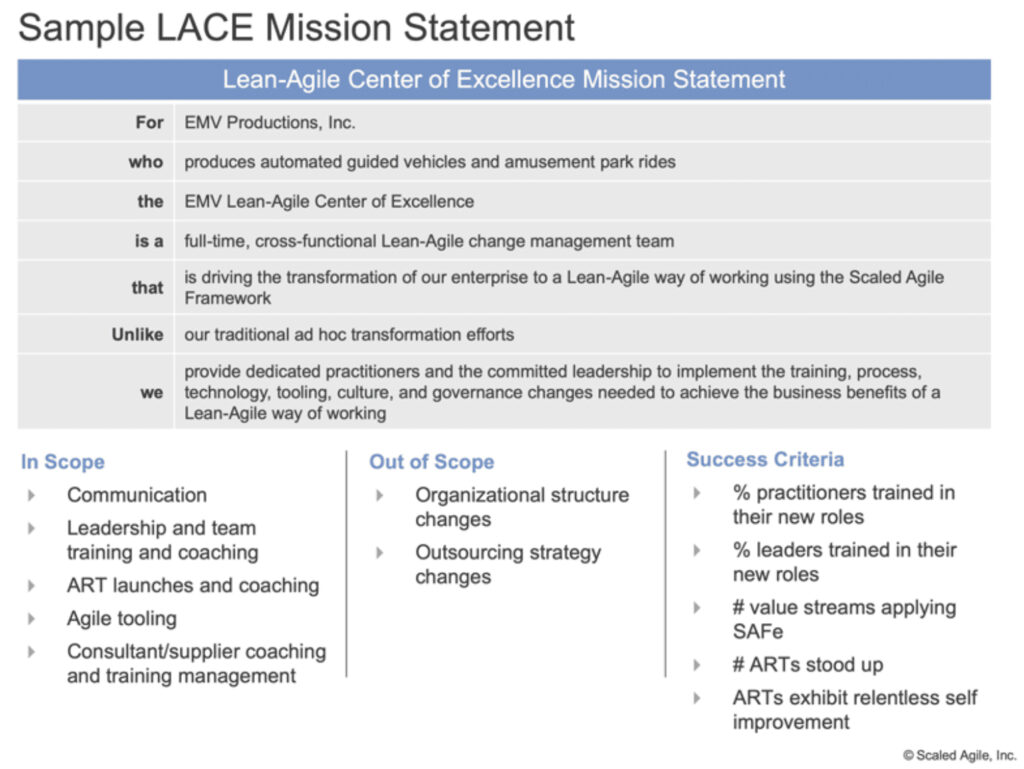
The LACE must align on a common mission statement. The mission statement gives the LACE a measuring point to help determine transformation scope and success.
You can use the recommended structure provided in the Framework article (shown in the preceding graphic) when writing your mission statement.
Step 3 | Set preliminary goals
To frame your goals, you must understand the state you’re trying to reach. What are you trying to accomplish with business agility? To answer this question, it’s important to understand where other business areas are experiencing challenges. Talk to sales, compliance, operations, and other areas supporting solution delivery to learn their aspirational outcomes.
This allows you to design goals based on the organization’s needs.
A recent pattern gaining momentum is to set transformation OKRs for the SAFe implementation. The following sections include a few examples.
Short-term objectives:
- Shorten the delivery cycle by addressing silo-related handoffs and friction
- Introduce customer-centricity and a product discipline
Longer-term objectives:
- Enable business agility and sense and respond to change
- Foster employee engagement and respect for people
- Shape disruption
You might first use metrics like the number of ARTs launched and people trained. But these metrics are based on adoption rather than outcomes. It is recommended to pivot once you can demonstrate and articulate the aforementioned goals.
Make goals visible so everyone understands where the transformation is headed at all times.
Step 4 | Build relationships and get buy-in
When leaders are vulnerable and share both good and bad experiences, it normalizes that transformations can feel uncomfortable at times, but that’s not a reason to stop or slow down. This relationship-building can happen informally through peer connections or formally through Communities of Practice.
Do the roadshow. Make the long trek down the hall (or organize some Zoom meetings) to build relationships and understand what others are seeing. Implementation of mindset and principles will help resolve the challenges people are sharing with you. Share how this new way of working can help their specific business unit. This builds trust, supports a shared understanding, and fosters empathy.
Step 5 | Conduct empathy interviews
How do people speak about Agile? What are their opinions? What do they view as the challenges to them and their organization from Agile?
Tip: Use empathy interviews to find potential partners through sponsorship and vocalized support or participation.
Once you’ve accomplished these beginning steps, it’s time to consider the formation of your LACE. We’ve found that the formation of the LACE often correlates to the following factors:
- Executive sponsorship and willingness to dedicate people and fund the LACE
- Agile maturity level
- Number of ARTs
- Number of LACE members
The following sections will detail each of the most common LACE formations, and we’ll specifically focus on the following areas:
- When to mature your LACE formation
- What changes as your LACE evolves through different formations
- Success patterns for managing the change
- Personal insights from experienced change leaders
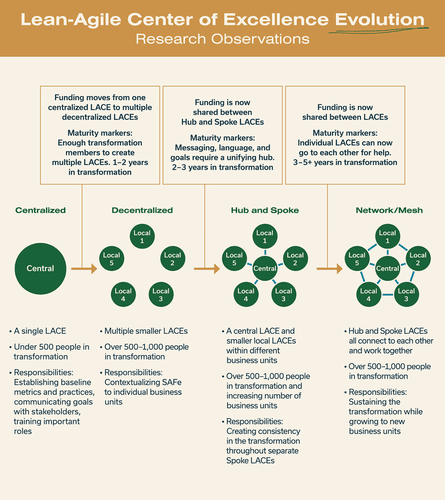
Centralized
Now that you can answer the question, “What is a lean-agile center of excellence?,” you’re ready to formalize and structure your LACE. We start with the centralized LACE because that’s where organizations often begin.
Forming one centralized team is the most logical step when creating your first LACE. Think of the first LACE as an incubator. Your goal is to find out what works, what doesn’t, and how to keep success patterns going. It may be a small team of two to three people or a slightly larger team of five to six people. Ideally, these members should have a foundational knowledge of SAFe (Leading SAFe®) and how to apply it (Implementing SAFe®).
Here are three steps to set and communicate your first priorities.
Measure the impact
One way to establish an organizational baseline and prioritize transformation work on your LACE roadmap is by facilitating an assessment. The Measure and Grow assessments on the SAFe Community Platform uncover strengths and areas for improvement. They also offer growth recommendations, which are specific tips tailored to your organization’s growth areas.
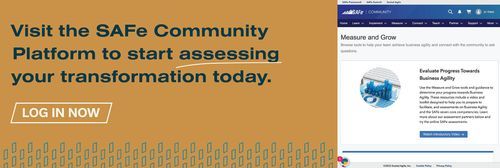
You can then use this data to determine your LACE’s priorities. To understand the organization as a whole, it’s best to survey as many teams as possible.
Tip: You should aim to start strong in the areas that will have the biggest impact. Your assessment data will show these areas.
Understand your responsibilities
With your data and priorities gathered, you should start the transformation strong by training and equipping members, especially leadership, with the resources they need for success.
The Framework article offers a large list of responsibilities for LACEs. While these responsibilities all add significant value, they tend to shift in importance over time. And we typically see the responsibilities increase in number and sophistication as a LACE matures.
The key focus areas for an early-stage centralized LACE include the following:
- Communicating the business need, urgency, and vision for change
- Developing the implementation plan and managing the transformation backlog
- Establishing the metrics
- Conducting or sourcing training for executives, managers and leaders, Agile teams, and specialty roles such as Product Owner, Product Manager, Scrum Master, and Release Train Engineer
- Facilitating Value Stream Identification Workshops (using supporting toolkit) and helping define and launch new Agile Release Trains (ARTs)
- Starting the LPM implementation journey
Tip: We recommend starting Value Stream Identification early in the transformation journey to organize around value and LPM. We understand that this may not be possible in your transformation. Introduce them as soon as there’s a need and continue to revisit them over time.
Communicate early and often
Transparency is an important tenet of a successful transformation. Communication is one way to encourage transparency. Communicate the LACE structure, members, mission, priorities, and goals out to the whole enterprise (or at least the ART). You can even share some of your early wins or lessons.
Metrics can help establish a routine communication avenue. Sharing progress through metrics in a way the whole enterprise can understand will increase buy-in for the transformation.
Challenges for a Centralized LACE
Here are some of the challenges that can occur when transitioning to a centralized LACE.
Prevent regression
As the LACE extends the transformation and moves on to launch the next team, ART, Value Stream, or Portfolio, the LACE needs measures in place to continue the support for previously-launched groups.
The LACE must provide the previously launched groups with continuous learning opportunities, on-demand assets, and tools to be able to do their day-to-day job in a SAFe environment.
One way to avoid this regression is through SAFe Enterprise and the SAFe Community Platform. These solutions enable “beyond classroom” role growth within your organization.
Avoid burnout
The LACE has to extend and sustain the transformation. This is almost too much. Creating a plan to balance capacity is a good way to ensure this challenge does not affect the centralized LACE. Consider augmenting your capacity with external partner experts.
Assessment Success Patterns
Create a working agreement and coach leadership that the assessments are not about judgment but to foster continuous improvement. You can use the following statements to help communicate the value of assessment:
- Be realistic; otherwise, there’s nothing to learn.
- We can always get better together.
- The more you do it, the more we can improve.
Create a safe space for assessment; feeling threatened will create more reservations in engagement. Build camaraderie as a team.
Bonus tips:
- Encourage participants to take their time on the assessment, especially if it’s the first time they’re experiencing a particular assessment.
- Discuss the meaning of the questions to ensure the responses are informed.
- Set the foundation that assessments will be taken every PI. Help participants understand what’s in it for them and how you will use the assessment to help them.
For more assessment success patterns, watch this webinar.
Decentralized
Locally-funded LACEs sometimes emerge in different business units. These LACEs are typically responding to a local need to adopt Lean-Agile in that particular group.
Siloeing is a common challenge for decentralized LACEs. Without consistent communication and collaboration, LACEs can lose cross-functional benefits and miss out on economies of scale with tooling and training acquisition.
One way to solve this challenge is through inter-LACE collaboration, which is one of the themes we found in our research. Ideas for collaboration include:
- Coach collaboration on success patterns, materials, and tooling
- Global LACE Communities of Practice that meet regularly (once a PI) to discuss knowledge, PI Plans, and success patterns
- Monthly LACE syncs
Read the Network/Meshed section to learn more about how to incorporate these collaboration opportunities.
Hub and Spoke
The Hub and Spoke structure fosters more LACE collaboration and mutual reinforcement of transformation goals. The same pressures and changes that prompt a shift from a centralized to decentralized LACE still apply to the Hub and Spoke formation. Specifically, the Hub and Spoke formation is designed to drive uniformity in messaging, practices, and overarching goals throughout an enterprise.
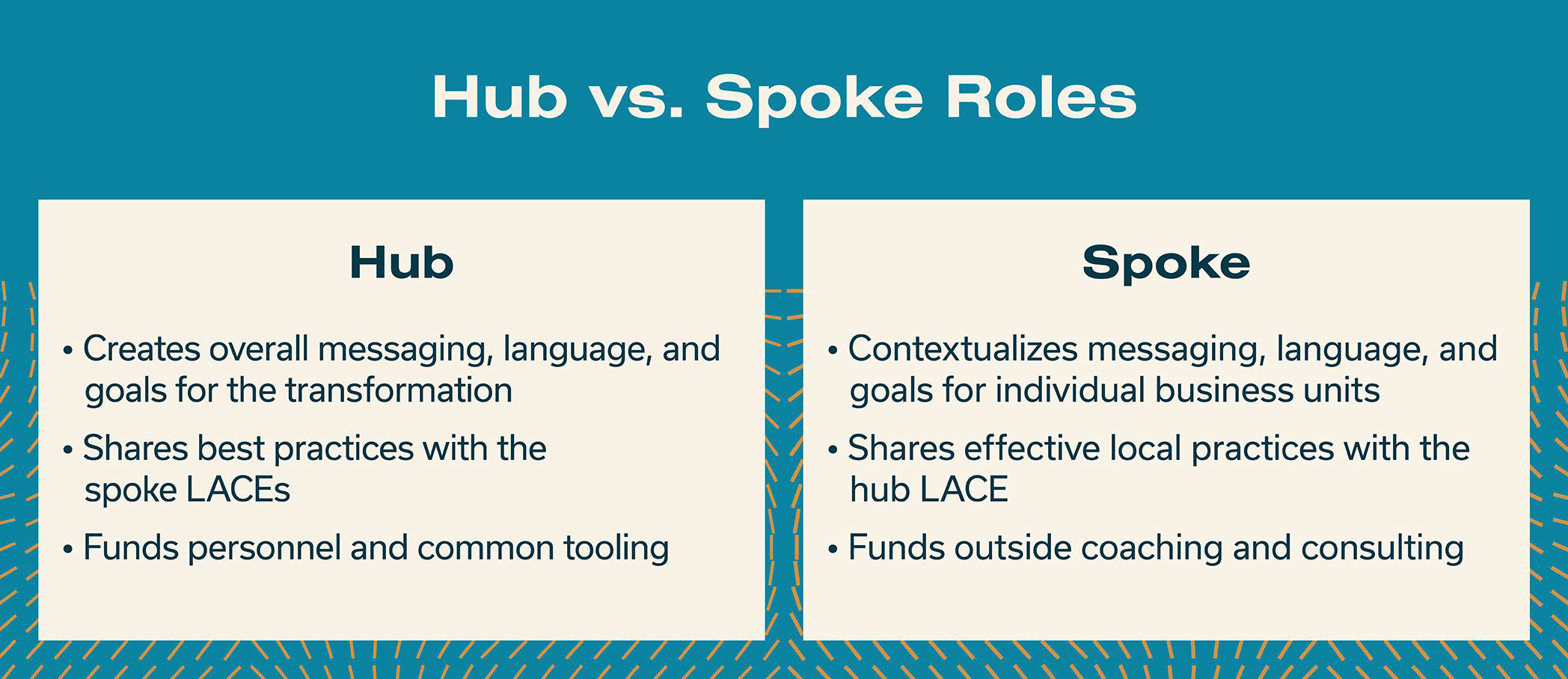
To keep the transformation consistent but not too prescriptive, the “hub” and “spoke” LACEs have different roles:
- The central hub creates overall messaging, language, overarching goals, and foundational practices for the transformation. It also develops success patterns to share with the various “spoke” centers. These success patterns form a foundation for any smaller LACE that’s formed to support new transformation areas and business units. The central hub also houses funding for personnel and common tooling used by all LACEs.
- The Hub can provide the value of standardization where it matters to the other LACEs. This can include the following examples:
- Offer enterprise-wide classes to help employee advancement and role-based learning needs for new hires
- Common toolsets for Agile work tracking
- Standards for Epic to story work taxonomy
- Job architectures and career paths for Agile roles
- An Enterprise subscription to SAFe
- Enterprise-level Lean Portfolio management solutions
- The individual, smaller spoke LACEs use goals from the central LACE and contextualize them to their team’s function and capabilities. The primary focus of the local LACE is still to achieve business outcomes for their local business unit or group.
The LACEs that support individual business units have the authority to adapt the transformation to their needs, including funding. This structure allows the LACEs to maintain the right balance of consistency and necessary adaptation.
Smaller LACEs can also rely on the hub for support or capacity.
Responsibilities
Some of the new responsibilities at this stage include
- Fostering SAFe Communities of Practice (CoPs)
- Offer enterprise-wide classes and training
- Common toolsets for Agile work tracking
- Standards for Epic to story work taxonomy
- Job architectures and career paths for Agile roles
- An Enterprise subscription to SAFe
- Introducing Lean Portfolio management solutions
- Implementing Lean-Agile focus days with guest speakers and presenting internal case studies
Challenges
Although spoke LACEs communicate with the Hub, they don’t necessarily communicate with each other. Most communication routes through the Hub, which could create bottlenecks and information gaps.
Along with new challenges come new opportunities. This LACE structure allows for cleanup of “organically launched” ARTs without sufficient training and coaching that may need to reevaluate their structures and practices. It also allows the transformation to spread to new areas of the business with a common language and method.
Tips
- Create an implementation roadmap and adapt it over time
- Capture and highlight quick wins by delivering what you committed to
- Manage the transformation flow and visibility through a Kanban
Networked/Meshed
We are excited about the emergence of this new pattern, which is not currently included in the Framework article as it was only recently uncovered in our research. This Networked/Meshed formation comprises a collaborative, connected network of LACEs that work together to accomplish the transformation.
LACEs in this formation are several years into their transformation and morph into a more collaborative dynamic instead of competitive against each other. Network/Meshed model LACEs now help each other when capacity allows and leverage the hub LACE for standards and items that provide economies of scale. They share success patterns, findings, and common challenges.
The main priority of the Network/Meshed model is to sustain the transformation while growing it to new business units. The initially-trained business units must retain their effectiveness and commitment to Agile work while the LACE focuses on new business units. Those groups must be self-sustaining to ensure a successful transformation long term.
Some of the new LACE responsibilities at this stage include:
- Promoting continuing Lean-Agile education
- Extending Lean-Agile practices to other areas of the company, including Lean Budgets, Lean Portfolio Management, contracts, and human resources
- Helping to establish relentless improvement (see Accelerate in the Implementation Roadmap)
Some of the major challenges include:
- Sustaining the transformation
- Managing complexity
- Finding people to support Enterprise transformation
We’ll cover these challenges more in a later section.
New opportunities for this model:
- Coaches can collaborate to support others when capacity and knowledge allow across the enterprise
- Global LACE CoPs allow experts to gather at a regular cadence to share knowledge, PI Plans, and what they’ve found in practices and patterns
- Monthly LACE sync with LACE members or leaders
Common LACE Challenges
Some of the LACE challenges we’ve uncovered apply to all formations. Many of these challenges are rooted in the same question: how do we sustain our transformation? We asked LACE members to identify their top concerns, and the following graphic outlines their poll responses.
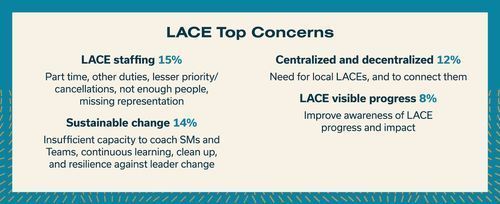
Challenge 1: Understaffed
Example: Demands are growing; especially from non-IT business areas that want to learn more about the Lean-Agile approach.
An understaffed LACE is a common problem, and it’s most prevalent when there is a need to accelerate the transformation to show a bigger impact. One way to overcome this challenge is to borrow expertise from other LACEs. Another option is to augment capacity with external partner experts.
Challenge 2: Budgeting for the LACE
Example: We don’t have the funding to do needed training. To start the LACE, members need a basic level of SAFe knowledge. Specific roles also need to understand their part in the LACE and transformation. Lack of funding to adequately train these roles creates a block for the LACE.
In addition, there are other costs related to external coaching, SAFe events, standardized tooling, and attending conferences to name a few. Here are examples of what the participating LACEs indicated they budget for every year:
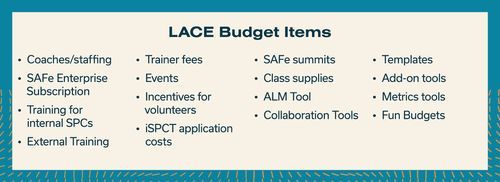
One possible solution is SAFe Enterprise.
We learned in our research that the SAFe Enterprise subscription was useful in these surprising ways:
- One LACE found it easier than asking for class funding from each group they need to train, which can discourage departments from sending their people to training.
- Another LACE had the clever approach of offering Enterprise level SAFe classes and self-funding the subscription through classes. In other words, subscription funding is centralized and back-charged.
Challenge 3: Sustaining the transformation
Example: How do we make sure the groups we invested in are still on track now that we’ve moved to other areas?
We recommend a few approaches to solve this issue.
- First, build resilience to weather leadership changes. Leadership needs to do more than support the transformation. They must participate in and accelerate the change through coaching, establishing relationships, and helping people succeed and do the right things for customers.
- Second, provide support after class with tools, resources, and additional learnings to help support a new way of working. SAFe Enterprise is a powerful enabler because it gives anyone using SAFe access to the full system, including training, on-demand learning, business agility assessments, and executive workshops.
- Third, tune-up organically formed ARTs. You may want to revisit some of the first ARTs you launched to apply new learnings or practices you’ve honed throughout the transformation process.
Challenge 4: How do I make my impact as a LACE visible?
Example: How do we show our progress and return on investment as a LACE?
Establishing your baseline metrics is critical for showing impact. You can use these metrics to share successes along the journey through the implementation roadmap you’ve created. And you can start with whichever metrics make sense at the time, knowing they will evolve.
Share your progress and impact widely. Use Intranet pages, employee town halls and meetings, physical boards in high-traffic areas in your office, or a cadence of LACE debriefs with a Q&A made available to the organization.
Your responsibility as a LACE includes active and continuous communication with the organization about what you do and the impact it’s having. Not only will it fuel the transformation, but it will also help your LACE sustain the funding they need to continue to deliver value.
Early measurements at the team level
From the beginning, you can measure flow metrics like Flow Time. How long does it take to bring value to customers in various areas? The Team and Technical Agility assessment is also a great source to help the team identify the next opportunity for improvement.
Mature measurements at the ART level
At the ART level, you can understand how ARTs release features. Start with predictability since it’s captured every PI. Flow metrics at the ART level are equally important.
On a portfolio level, it’s important to understand how long it takes to bring an idea to customers. This time can be broken into decision and implementation. Once you have this baseline, you can show how the time it takes to make decisions and implement them shrinks over time.
Aside from time, measure whether the right investments are prioritized through tracking OKRs for the Strategic Themes. Look for indications of “agility” within the LPM decision-makers, either through anecdotal examples or measures of stopped or discarded initiatives due to a change in value compared to other investments.
Ways to make transformation metrics visible
Depending on if your organization is remote or in-person, there are a variety of ways to make transformation metrics visible. Choose one or some combination based on what works best in your organization.
- Create a dashboard with descriptions of the metrics, how to interpret them, and coaching guidance (if you want to do X, here’s what to think about)
- Use a visual management tool like iObeya for remote teams or business units
- Create flipcharts and make them clearly visible to everyone in an office setting
And don’t consider any wins too small to share. You want leadership to see what you’re accomplishing, even if they’re small wins that will lead to larger initiatives in the future.
FAQs and More Learning
Should the LACE operate like an Agile team?
Yes, the LACE needs to operate like an Agile team. This helps members of the LACE model the Agile behaviors and mindsets they’re coaching others to emulate.
To do this, start with the basic Agile team structure, like Scrum or Kanban, and then ART-level ceremonies and artifacts, like PI planning and a roadmap.
Should we include external contractors in our LACE?
If external contractors are on-site partnering with you for a transformation, you can use their knowledge to evolve the LACE and to coach and mentor your coaches or develop internal SPC or coach skills.
What role does the LACE play in LPM?
The LACE brings expertise and knowledge to implement LPM. They often teach the LPM course to the PMO and portfolio management groups. They also enable the groups that will own LPM operations in the long run through mentoring and co-facilitating the early LPM events.
Typically, in the long run, LPM facilitation/operation transitions to the portfolio operations group.
More Learning Resources
- SAFe Jumpstart online learning series
- Administrator assignment of online learning series
- Transformation in Practice webinar series (here’s an alternate link for community members outside an Enterprise subscription)
- Value Stream Mapping workshop
- Organize Around Value practice guide
- LPM Getting Started Workshop accessed through the LPM course
- LPM Practice Guide modules: Align, Strategize, and Operate
- Participatory Budgeting practice assets
- LACE and Transformation discussion forum
- Tactical Tip Tuesday: LACE Tips podcast

A SAFe Fellow, Deema Dajani helps large institutions create the environment to shape disruption like a startup with business agility and Lean Portfolio Management (LPM). Deema currently serves as a Scaled Agile Product Management Director focused on enabling sustainable SAFe transformations at scale. Co-founder of Women in Agile, a non-profit organization focused on breaking barriers and inclusivity in the Agile community. Connect with Deema on LinkedIn.
